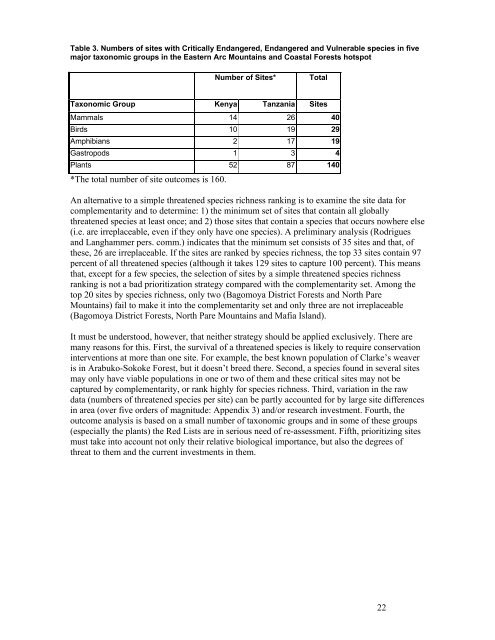Eastern Arc Mountains and Coastal Forests of Tanzania and Kenya ...
Eastern Arc Mountains and Coastal Forests of Tanzania and Kenya ...
Eastern Arc Mountains and Coastal Forests of Tanzania and Kenya ...
Create successful ePaper yourself
Turn your PDF publications into a flip-book with our unique Google optimized e-Paper software.
Table 3. Numbers <strong>of</strong> sites with Critically Endangered, Endangered <strong>and</strong> Vulnerable species in fivemajor taxonomic groups in the <strong>Eastern</strong> <strong>Arc</strong> <strong>Mountains</strong> <strong>and</strong> <strong>Coastal</strong> <strong>Forests</strong> hotspotNumber <strong>of</strong> Sites*TotalTaxonomic Group <strong>Kenya</strong> <strong>Tanzania</strong> SitesMammals 14 26 40Birds 10 19 29Amphibians 2 17 19Gastropods 1 3 4Plants 52 87 140*The total number <strong>of</strong> site outcomes is 160.An alternative to a simple threatened species richness ranking is to examine the site data forcomplementarity <strong>and</strong> to determine: 1) the minimum set <strong>of</strong> sites that contain all globallythreatened species at least once; <strong>and</strong> 2) those sites that contain a species that occurs nowhere else(i.e. are irreplaceable, even if they only have one species). A preliminary analysis (Rodrigues<strong>and</strong> Langhammer pers. comm.) indicates that the minimum set consists <strong>of</strong> 35 sites <strong>and</strong> that, <strong>of</strong>these, 26 are irreplaceable. If the sites are ranked by species richness, the top 33 sites contain 97percent <strong>of</strong> all threatened species (although it takes 129 sites to capture 100 percent). This meansthat, except for a few species, the selection <strong>of</strong> sites by a simple threatened species richnessranking is not a bad prioritization strategy compared with the complementarity set. Among thetop 20 sites by species richness, only two (Bagomoya District <strong>Forests</strong> <strong>and</strong> North Pare<strong>Mountains</strong>) fail to make it into the complementarity set <strong>and</strong> only three are not irreplaceable(Bagomoya District <strong>Forests</strong>, North Pare <strong>Mountains</strong> <strong>and</strong> Mafia Isl<strong>and</strong>).It must be understood, however, that neither strategy should be applied exclusively. There aremany reasons for this. First, the survival <strong>of</strong> a threatened species is likely to require conservationinterventions at more than one site. For example, the best known population <strong>of</strong> Clarke’s weaveris in Arabuko-Sokoke Forest, but it doesn’t breed there. Second, a species found in several sitesmay only have viable populations in one or two <strong>of</strong> them <strong>and</strong> these critical sites may not becaptured by complementarity, or rank highly for species richness. Third, variation in the rawdata (numbers <strong>of</strong> threatened species per site) can be partly accounted for by large site differencesin area (over five orders <strong>of</strong> magnitude: Appendix 3) <strong>and</strong>/or research investment. Fourth, theoutcome analysis is based on a small number <strong>of</strong> taxonomic groups <strong>and</strong> in some <strong>of</strong> these groups(especially the plants) the Red Lists are in serious need <strong>of</strong> re-assessment. Fifth, prioritizing sitesmust take into account not only their relative biological importance, but also the degrees <strong>of</strong>threat to them <strong>and</strong> the current investments in them.22
















